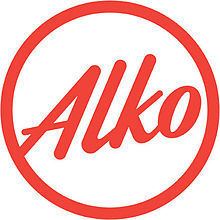Industry Alcoholic beverages Operating income Customer service 00 358 20 692771 Number of employees 2,741 Type State-owned enterprise | Products Alcoholic beverages Website www.alko.fi CEO Hille Korhonen (2013–) Founded 5 April 1932 | |
 | ||
Key people Hille Korhonen (President and CEO) Revenue 1,172.6 million € (2009) Profiles | ||
Alko is the national alcoholic beverage retailing monopoly in Finland. It is the only store in the country which retails beer over 4.7% ABV, wine (except in vineyards) and spirits. Alcoholic beverages are also sold in licensed restaurants and bars but only for consumption on the premises. Alko is required by law to sell drinks with lower alcohol content than 4.7% and non-alcoholic alternatives, but in practice carries a very limited stock of low alcohol beer, cider and non-alcoholic drinks and mixers as supermarkets sell the same products at a lower price. By law, alcoholic drinks may only be sold to those aged 18 or above.
Contents
Products
As the only retailer of strong alcoholic beverages in Finland, Alko has an extensive range of products ranging from rare wines to bulk vodka. Its wine selection has grown in recent decades as there has been an increase in consumption and a government drive to change Finnish drinking habits to a more "European" style, which means a move from hard liquor to wine and beer. While wine consumption has increased, this has not replaced consumption of other alcoholic beverages, negating the "Europeanisation" argument. Nowadays wines occupy most of the shelf space in an Alko shop. Its beer selection is concentrated on stronger versions of the domestic bulk lagers and some high-quality strong beers from major beer-producing countries as well as traditional Sahti at some locations. Hard spirits include several Finnish brands of vodka and all major types of hard liquor. Alko also sells brands of drinks produced by the Finnish state-owned company Altia, which are traditional products and not sold abroad. Many of these date back to the first products launched after the end of prohibition in Finland. These are usually for mixing drinks.
Legal status
Alko is a government-owned enterprise reporting to the Finnish Ministry of Health and Social Affairs. As of December 2009, it has 346 shops and 121 order points throughout the country. Alko shop locations have to be approved by National Supervisory Authority for Welfare and Health (Finnish abbreviation Valvira). Only once has an application for a new Alko shop been denied. In 2003, an application for a location in Koivukylä, Vantaa, was rebuffed because there was a kindergarten next to the planned location. Earlier shops were located separately from other retail outlets, but beginning in the 1990s a growing number of Alkos have appeared in malls and supermarkets, some even in gas stations. Under the Alcohol Act, Alkos cannot have a window display, so stores often have a display of wine glasses and catalogues.
Alko can advertise beverages that contain up to 22% alcohol. In practice, manufacturers or distributors, not Alko, advertise their products. There is a total ban on advertising beverages stronger than 22%.
On the February 3, 2005, the Finnish Food Marketing Association (a pressure group of the country's supermarkets like K-Kauppa and S-Group) asked the European Union to challenge the legality of Alko's monopoly, which it disputes.
Products with under 22% ABV can be purchased by individuals at least 18 years of age. The minimum age for products containing over 22% ABV is 20. When asked at checkout a customer must prove his or her age with an official ID (only a driver's licence, ID card or passport is accepted). Alcohol will not be sold to visibly intoxicated customers or when there is a reason to suspect misuse or illegal supply to a person who would not be authorized to buy. Persons under the age of 18 are prohibited from entering an Alko unless accompanied by an adult.
History
From 1919 to 1932, the distribution and consumption of alcoholic beverages was forbidden in Finland. When the prohibition was lifted by the Finnish government in 1932 following a referendum, they created a company called Oy Alkoholiliike Ab which was fully owned by the government.
The first stores were opened on the 5th of April, 1932, at 10:00. (The date and time form the number 543210, still appearing in trivia quizzes.)
During the 1939-40 Winter War the company mass-produced molotov cocktails for the Finnish military, production totalling 450,000 units.
In 1969 the company's name was changed to Oy Alko Ab. This company not only distributed, but imported and manufactured, alcohol.
In the 1980s, Alko stores switched from desk service to self-service.
In 1995, when Finland joined the EU, the monopolies in production and import had to be lifted. Thus, the corporation was separated into Alko (distribution), Primalco (production) and Havistra (bulk sales), which formed the Altia Group; only Alko retained a monopoly. In 1998, Alko was separated from the Altia Group, and is now entirely separated from it, although Alko continues to be the major customer of Altia. Altia Group (with Primalco and Havistra) was reorganized later to the current Altia.
The history of Alko is presented at the Hotel and Restaurant Museum in Helsinki.
